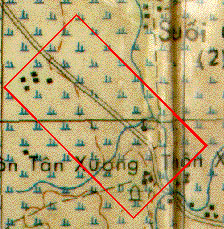 |
| Extraction from Thon Tan Xuong |
Scenario
|
This scenario follows on from the previous 'Assault on Thon Tan Xuong'. This time there were five players, one Vietcong platoon commander, one US company commander, three US platoon commanders. A platoon of ARVN was contolled by the US company commander. The US rifle company (minus weapons platoon) and an ARVN rifle platoon had taken the village in the previous battle. The US troops set up on table, while the VC player drew his attack plan onto a map. The VC lacked radios, so troops were forced to stick to the plan rather than react as the battle unfolded. To reflect this the VC platoons would have to stick to their pre-planned orders. |
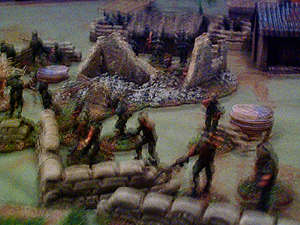 US Troops in their NDP |
US Briefing
|
|
Having successfully gained position of the village, there was not time to extract the company in daylight, so your company established a Night Defensive Position (NDP) just outside the main village, and were resupplied by helicopter. All ammunition levels have been replenished, and you have also been supplied with a Heavy Machine Gun and 10 Claymores. Your casualties from the previous days' fighting have all been extracted, but not replaced. No support has been specifically allocated, but artillery and gunships are on call if required. The night passed uneventfully and it is now morning. Your company must sweep the area to secure a landing zone, and will then be extracted by Hueys. |
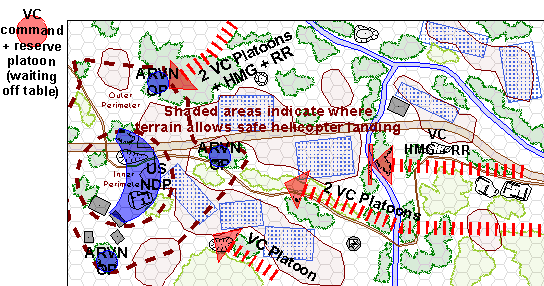
Deployment
|
|
The US had to set up the majority of their troops on the Eastern edge of the village, but they were allowed 3-man observation posts set up further away. The players elected (somewhat unrealistically) to use the ARVN as the observation posts, under the dubious justification that they could speak Vietnamese, and so might be able to understand the commands of the attackers. The remains of the ARVN were located at the south end of the NDP. The map above shows initial positions and the directions of the VC attack. |
First Moves
|
|
The VC player had decided to hold his troops in position, until the attack was signalled by two red flares, fired from the command position, which was off table on a small rise, observing the battlefield. As the area was quiet, the US captain (Phil again) decided to send out troops and to start sweeping the area. A platoon or so started to move cautiously north in squads, keeping to the cover and thoroughly checking all areas. |
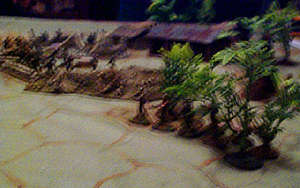 The US defensive line |
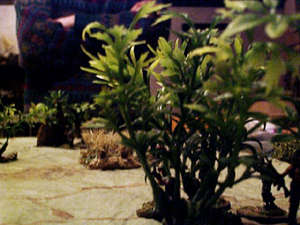 US patrols fan out through the jungle |
The attack starts
|
|
Once the US troops had moved up to the north-west corner of the table, and had started to become quite spread out, the VC player (Matt) decided to signal the attack. The next turn, the two rifle platoons waiting on the north end of the field started moving on. One squad advanced, line abreast, but was almost immediately cut down by ambush fire from the US troops in the surrounding jungle. The US players were congratulating themselves on their success, when another squad advanced, then another and another. Bodies were piling up rapidly, but the VC were starting to return effective fire. First the troops at the ARVN observation post were cut down, then three or four US troops in the nearest treeline. There was no time to attend to the casualties, as both sides concentrated on gaining fire superiority, (using Aggressive fire orders). The VC started to advance along a broader front, with squads arriving on the north table edge over a 40" (400 yard) frontage. US fire had been checked by the VC response and although casualties were taken, the majority of the VC reached the cover of the large patch of jungle, and turned west towards the US lines. Once the bulk of the VC had disappeared into the jungle, the US squads gained fire superiority and soon killed or suppressed the remaining VC still firing. |
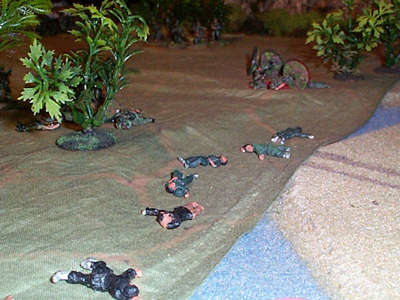 Casualties on both sides pile up |
Another flank goes in
|
|
Meanwhile, more VC were moving up on the southern end of the VC line. Small numbers of troops were infiltrating the treeline, using their fieldcraft to avoid detection. Inevitably, however, some were spotted and the US opened up with Ambush Fire. The VC already in position responded in the main Fire Phase and a vicious battle erupted. VC squads were coming out of the jungle at a rate of roughly one per turn, and the US, even with their machine guns blazing, were having difficulty containing them. Under pressure at both ends of the table, things were starting to look nasty. |
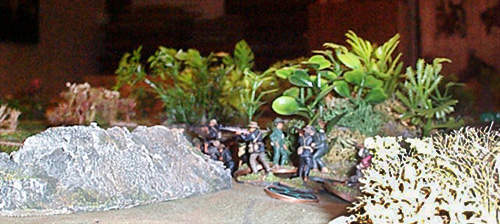 More VC assault the NDP from the south side |
Supporting fire
|
|
The US captain realised that they were unlikely to be able to hold them off unaided and called for a battery of 105mm howitzers. Fortunately the howitzers had fired ranging shots when the Night Defensive Position had been established, so the artillery was in a position to fire swiftly and accurately (although it would still take a few turns to come). First he called it in (or rather his attached Artillery Forward Observer did) on the large area of jungle to the north where most of two platoons of VC had been seen to disappear. Having more or less gained control of the situation, the US troops started to form a more solid and coherent firing line, ready to engage any VC emerging from the northern jungle. Meanwhile, the battle raged between the southern VC platoon and ARVN and US troops dug in at the edge of the village. |
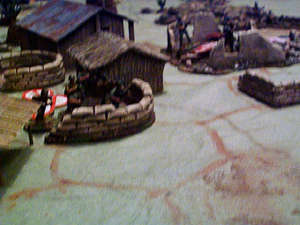 US & ARVN hold their ground |
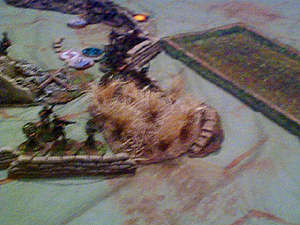 Ammo starts to run out |
Gunship attack
|
|
Not content with using artillery, the US captain had called for gunship support, and a heavy fire team of three helicopters now turned up. Careful not to cross the incoming artillery, they began strafing the line of woods through which the VC were attacking the south flank, with rocket and machine gun fire. The concentration of fire was so heavy in this narrow area that almost all the troops within it became casualties after a couple of attack runs. There was a limited amount of VC return fire against the gunships which were flying low and fairly slowly to maximise their fire on the target area. One of the gunships had its radio destroyed completely and was forced to return to base. The other two stayed on station, waiting for fresh targets to reveal themselves. Once the constant flow of reinforcements stopped the US and ARVN started to get the better of the southern VC, and soon the VC began to retreat as they no longer had sufficient numbers to significantly oppose the Free World forces. |
 The business end of a UH-1C gunship |
Cleaning up
|
|
The artillery battery fire mission was now ready to fire, this would neutralise an area over 10" square (100m) which covered most of the target jungle area. High Explosive shells can easily be set off by the trees, sending showers of lethal shrapnel down on the troops below, so the woods would actually increase the effect of the artillery, rather than decreasing it. The artillery barrage was devastatingly effective, causing over two thirds casualties in the VC unit. The crushing power of the US support fire had broken the VC assault. Sensing victory, the US troops formed a skirmish line of over platoon strength and braved the woods, but the VC had melted away before them. |
 Artillery flattens the northern woods as US advance. |
Analysis
|
|
The US side took seventeen casualties, half US and half ARVN, but the VC withdrew leaving over hundred on the field. This ratio of casualties was entirely realistic for an action in which the US forces could bring the crushing power of their supporting fire to bear. For this reason ground troops seldom operated outside the range of artillery batteries, and the VC developed a number of tactics to minimise their exposure, such as hugging the US troops to closely to be hit with support fire, or very quick hit and run attacks. Although this might look like a crushing US victory (and in many ways it was) the VC did not do too badly, given the support fire they faced. In terms of playing a scenario it was a marginal VC loss. |
![]()
©2003. All rights reserved.
![]()
